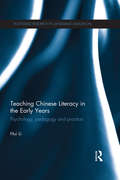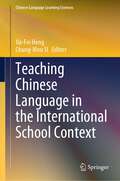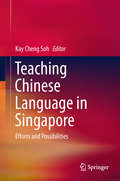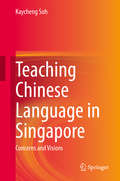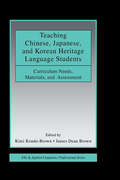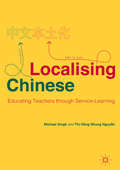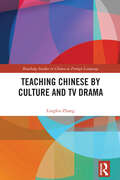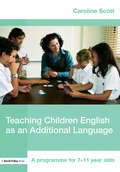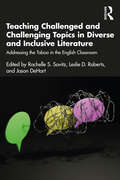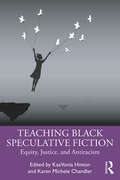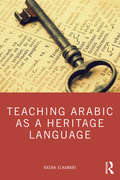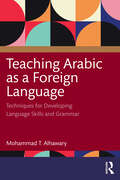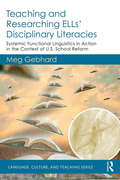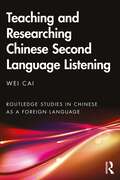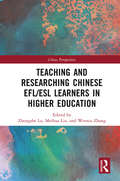- Table View
- List View
Teaching Chinese Literacy in the Early Years: Psychology, pedagogy and practice (Routledge Research in Language Education)
by Hui LiThe Chinese language is now used by a quarter of the world’s population and is increasingly popular as a second language. Teaching Chinese Literacy in the Early Years comprehensively investigates the psychology, pedagogy and practice involved in teaching Chinese literacy to young children. This text not only explores the psycholinguistic and neuropsychological processing involved in learning Chinese literacy but also introduces useful teaching methods and effective practices relevant for teaching within early years and primary education. Key issues explored within this text include: The Psycholinguistics of Chinese Literacy Neuropsychological Understanding of Chinese Literacy The pedagogy of teaching Chinese as a first language The Pedagogy of Teaching Chinese as a second language Teaching Chinese literacy in early childhood settings Assessing Chinese Literacy Attainment in the Early Years With the addition of two reliable Chinese literacy scales, Teaching Chinese Literacy in the Early Years is an essential text for any student, lecturer or professional teacher who is interested in learning and teaching Chinese literacy.
Teaching Chinese Literacy in the Early Years: Psychology, pedagogy and practice (Routledge Research in Language Education)
by Hui LiThe Chinese language is now used by a quarter of the world’s population and is increasingly popular as a second language. Teaching Chinese Literacy in the Early Years comprehensively investigates the psychology, pedagogy and practice involved in teaching Chinese literacy to young children. This text not only explores the psycholinguistic and neuropsychological processing involved in learning Chinese literacy but also introduces useful teaching methods and effective practices relevant for teaching within early years and primary education. Key issues explored within this text include: The Psycholinguistics of Chinese Literacy Neuropsychological Understanding of Chinese Literacy The pedagogy of teaching Chinese as a first language The Pedagogy of Teaching Chinese as a second language Teaching Chinese literacy in early childhood settings Assessing Chinese Literacy Attainment in the Early Years With the addition of two reliable Chinese literacy scales, Teaching Chinese Literacy in the Early Years is an essential text for any student, lecturer or professional teacher who is interested in learning and teaching Chinese literacy.
Teaching Chinese Language in the International School Context (Chinese Language Learning Sciences)
by Jia-Fei Hong Chung-Mou SiThis book explores the learning and teaching of K-12 Chinese language in international schools. The authors of this book are scholars from teaching training institutions and universities, as well as professional frontline teachers. With a combination of the works and insights from both perspectives of theory and practice, the book presents how theories of teaching can be operated in classroom to improve the effectiveness of language teaching. It covers curriculum setting, design of teaching materials, teaching principles, methods, strategies, and evaluation. The book also discusses issues and concepts such as concept-driven learning, identity change and recognition of L1 and L2 Chinese teacher, pinyin teaching, Chinese character teaching, evaluation for learning improvement, and integration of South Asian non-Chinese speaking students into local schools. It emphasizes empirical action research methods. This is a highly informative and carefully presented book, providing high value insights to scholars from university and teacher training institutions and teachers from kindergartens, primary, and secondary schools around the world.
Teaching Chinese Language in Singapore: Efforts and Possibilities
by Kay Cheng SohThis book presents the experiences of Chinese Language researchers in Singapore to Chinese Language researchers and teachers in other countries and regions, such as the USA, the UK and Asia, that are home to a large number of learners, young and old. As such, the innovative ideas it provides can be applied in practising teachers’ classrooms to promote more effective and efficient student learning. Beyond pedagogical innovations, the book also includes papers on the assessment of Chinese Language learning and teacher literacy – two areas that have been largely neglected by the Chinese Language research and teaching communities, not only here in Singapore, but also around the world. This book, the sequel to “Teaching Chinese Language in Singapore: Retrospect and Challenges” (Springer, 2016), is future-oriented, highlighting ideas that merit further attention from researchers and practitioners alike.
Teaching Chinese Language in Singapore: Concerns and Visions
by Kaycheng SohThis book addresses the problems and issues surrounding teaching Chinese as a second language in the Singapore context. It identifies four main areas of concern: (1) Neglect of culture in the teaching of Chinese; (2) Difficulty of learning Hanzi (Chinese characters); (3) Cognitive and affective aspects of Chinese language learning; and (4) Authenticity of the Chinese language in a global and Singapore context. The book includes lesson design and instructional practices for re-prioritizing Chinese as a set of trainable skills, as well as teaching culture in the context of teaching the language. It also introduces the Chinese as a Second Language Readability Formula to help learners overcome their difficulties with learning Hanzi (Chinese characters), and the Attitude Toward Chinese Language Scale to help understand the various factors that can influence Chinese language learning. It also proposes a student-oriented model for conducting problem-based research, tapping into the disciplines of psycholinguistics and sociolinguistics.Resolving or minimizing the issues identified here requires action at the macro level by Chinese language researchers on a national scale, and at the micro level by classroom teachers through action research.
Teaching Chinese, Japanese, and Korean Heritage Language Students: Curriculum Needs, Materials, and Assessment (ESL & Applied Linguistics Professional Series)
by Kimi Kondo-Brown James Dean BrownThis book contributes to building the research knowledge that language teaching professionals need in developing curriculum for the large population of East Asian heritage students (including Chinese, Japanese, and Korean) in countries like the United States, Canada, and Australia, where speakers of East Asian languages are among the fastest growing populations. Heritage learners are defined as those who initially acquired certain levels of linguistic and cultural competence in a non-dominant language mainly through interaction with foreign-born parents and other family members at home. Heritage language instruction is currently a “hot topic” and is becoming a sub-discipline within the fields of foreign language education and applied linguistics. Special instruction for heritage language learners is on the rise, particularly in the U.S. and Canada. Providing theoretical and practical information about heritage-language instruction in terms of curriculum design, learner needs, materials development, and assessment procedures, the goal of this book is not only to promote research about heritage students in East Asian languages but also to improve the teaching of these students in various educational settings and all over the world, especially in English speaking countries. The volume is organized in four sections:*Overview—addressing the timeliness, necessity, and applications of the work and issues and future agendas for teaching Chinese, Japanese, and Korean heritage students;*Language Needs Analysis;*Attitude, Motivation, Identity, and Instructional Preference; and*Curriculum Design, Materials Development, and Assessment Procedures Teaching Chinese, Japanese, and Korean Heritage Language Students is intended as a primary text or reference for researchers, educators, and students in the areas of curriculum, pedagogy, and assessment studies related to teaching bilingual and heritage students in general and East Asian heritage students in particular.
Teaching Chinese, Japanese, and Korean Heritage Language Students: Curriculum Needs, Materials, and Assessment (ESL & Applied Linguistics Professional Series)
by Kimmi Kondo-Brown James Dean BrownThis book contributes to building the research knowledge that language teaching professionals need in developing curriculum for the large population of East Asian heritage students (including Chinese, Japanese, and Korean) in countries like the United States, Canada, and Australia, where speakers of East Asian languages are among the fastest growing populations. Heritage learners are defined as those who initially acquired certain levels of linguistic and cultural competence in a non-dominant language mainly through interaction with foreign-born parents and other family members at home. Heritage language instruction is currently a “hot topic” and is becoming a sub-discipline within the fields of foreign language education and applied linguistics. Special instruction for heritage language learners is on the rise, particularly in the U.S. and Canada. Providing theoretical and practical information about heritage-language instruction in terms of curriculum design, learner needs, materials development, and assessment procedures, the goal of this book is not only to promote research about heritage students in East Asian languages but also to improve the teaching of these students in various educational settings and all over the world, especially in English speaking countries. The volume is organized in four sections:*Overview—addressing the timeliness, necessity, and applications of the work and issues and future agendas for teaching Chinese, Japanese, and Korean heritage students;*Language Needs Analysis;*Attitude, Motivation, Identity, and Instructional Preference; and*Curriculum Design, Materials Development, and Assessment Procedures Teaching Chinese, Japanese, and Korean Heritage Language Students is intended as a primary text or reference for researchers, educators, and students in the areas of curriculum, pedagogy, and assessment studies related to teaching bilingual and heritage students in general and East Asian heritage students in particular.
Teaching Chinese In Schools: Learner-centred, Learning-focused Practices (Palgrave Studies in Teaching and Learning Chinese)
by Michael Singh Jinghe HanLearner-centred, Learning-focused Practices
Teaching Chinese by Culture and TV Drama (Routledge Studies in Chinese as a Foreign Language)
by Lingfen ZhangThis book integrates culture and authenticity into Chinese classroom practice through exploring the potential of contemporary TV drama as teaching and learning materials for intercultural Chinese language teaching and learning. In addressing the four main challenges in culture teaching in Teaching Chinese as a Foreign Language (TCFL), this book focuses on precisely this area of pedagogical practice in Chinese as foreign language education and draws on a wide interdisciplinary base, including foreign language education, cultural studies, and intercultural communication to explore the potential of authentic TV drama as language and culture materials for revitalising TCFL and foreign language teaching more generally. It examines in detail the culturally shaped beliefs, values, and practices that give meaning to the action and language of the selected clips in a modern, award-winning Chinese TV drama. This book shows a potential experiential pathway into (pedagogical) practices to bring contemporary culture into classrooms, to engage learners with contemporary and authentic texts, and to encourage inquiry-focused teaching practices, which – in being intercultural – allow for learners’ own interpretations of cultural messages in interaction and to recognise learners as learning to understand their own values and beliefs as they learn to explore those of other cultures.
Teaching Chinese by Culture and TV Drama (Routledge Studies in Chinese as a Foreign Language)
by Lingfen ZhangThis book integrates culture and authenticity into Chinese classroom practice through exploring the potential of contemporary TV drama as teaching and learning materials for intercultural Chinese language teaching and learning. In addressing the four main challenges in culture teaching in Teaching Chinese as a Foreign Language (TCFL), this book focuses on precisely this area of pedagogical practice in Chinese as foreign language education and draws on a wide interdisciplinary base, including foreign language education, cultural studies, and intercultural communication to explore the potential of authentic TV drama as language and culture materials for revitalising TCFL and foreign language teaching more generally. It examines in detail the culturally shaped beliefs, values, and practices that give meaning to the action and language of the selected clips in a modern, award-winning Chinese TV drama. This book shows a potential experiential pathway into (pedagogical) practices to bring contemporary culture into classrooms, to engage learners with contemporary and authentic texts, and to encourage inquiry-focused teaching practices, which – in being intercultural – allow for learners’ own interpretations of cultural messages in interaction and to recognise learners as learning to understand their own values and beliefs as they learn to explore those of other cultures.
Teaching Children English as an Additional Language: A Programme for 7-12 Year Olds
by Caroline ScottHere is a typical classroom scenario: out of the thirty children, two-thirds speak a different language at home and only speak English at school. Even though many pupils’ English skills are almost non-existent, teachers are expected to provide the national curriculum for every child in the class. Teaching Children English as an Additional Language solves this problem with a ten-week teaching programme of units and lesson activities for children aged seven–eleven (Key Stage 2) new to English. It will help these children learn some very basic English sentences, questions and vocabulary, to get them through regular day-to-day routines more easily. By offering a flexible step by step approach this book helps EAL teachers to: identify learners’ individual needs teach grammar and vocabulary support teaching through speaking and listening assess pupils to inform future planning The programme also contains emergency lessons to support learners in the first three days, cross curricular links, ways of using a home-school learning book and an opportunity for the child to make a booklet about themselves. It fosters the child’s home language, incorporates different learning styles as well as including a wealth of carefully tailored, themed resources. The programme is complete with activities, resources and assessment materials and helpful tips on how to develop a successful EAL department.
Teaching Children English as an Additional Language: A Programme for 7-12 Year Olds
by Caroline ScottHere is a typical classroom scenario: out of the thirty children, two-thirds speak a different language at home and only speak English at school. Even though many pupils’ English skills are almost non-existent, teachers are expected to provide the national curriculum for every child in the class. Teaching Children English as an Additional Language solves this problem with a ten-week teaching programme of units and lesson activities for children aged seven–eleven (Key Stage 2) new to English. It will help these children learn some very basic English sentences, questions and vocabulary, to get them through regular day-to-day routines more easily. By offering a flexible step by step approach this book helps EAL teachers to: identify learners’ individual needs teach grammar and vocabulary support teaching through speaking and listening assess pupils to inform future planning The programme also contains emergency lessons to support learners in the first three days, cross curricular links, ways of using a home-school learning book and an opportunity for the child to make a booklet about themselves. It fosters the child’s home language, incorporates different learning styles as well as including a wealth of carefully tailored, themed resources. The programme is complete with activities, resources and assessment materials and helpful tips on how to develop a successful EAL department.
Teaching Challenged and Challenging Topics in Diverse and Inclusive Literature: Addressing the Taboo in the English Classroom
by Rachelle S. Savitz Leslie D. Roberts Jason DeHartThis groundbreaking text provides practical, contextualized methods for teaching and discussing topics that are considered "taboo" in the classroom in ways that support students’ lived experiences. In times when teachers are scapegoated for adopting culturally sustaining teaching practices and are pressured to "whitewash" the curriculum, it becomes more challenging to create an environment where students and teachers can have conversations about complex, uncomfortable topics in the classroom. With contributions from scholars and K-12 teachers who have used young adult literature to engage with their students, chapters confront this issue and focus on themes such as multilingualism, culturally responsive teaching, dis/ability, racism, linguicism, and gender identity. Using approaches grounded in socioemotional learning, trauma-informed practices, and historical and racial literacy, this text explores the ways in which books with complicated themes can interact positively with students’ own lives and perspectives. Ideal for courses on ELA and literature instruction, this book provides a fresh set of perspectives and methods for approaching and engaging with difficult topics. As young adult literature that addresses difficult subjects is more liable to be considered "controversial" to teach, teachers will benefit from the additional guidance this volume provides, so that they can effectively reach the very students these themes address.
Teaching Challenged and Challenging Topics in Diverse and Inclusive Literature: Addressing the Taboo in the English Classroom
by Rachelle S. Savitz Leslie D. Roberts Jason DeHartThis groundbreaking text provides practical, contextualized methods for teaching and discussing topics that are considered "taboo" in the classroom in ways that support students’ lived experiences. In times when teachers are scapegoated for adopting culturally sustaining teaching practices and are pressured to "whitewash" the curriculum, it becomes more challenging to create an environment where students and teachers can have conversations about complex, uncomfortable topics in the classroom. With contributions from scholars and K-12 teachers who have used young adult literature to engage with their students, chapters confront this issue and focus on themes such as multilingualism, culturally responsive teaching, dis/ability, racism, linguicism, and gender identity. Using approaches grounded in socioemotional learning, trauma-informed practices, and historical and racial literacy, this text explores the ways in which books with complicated themes can interact positively with students’ own lives and perspectives. Ideal for courses on ELA and literature instruction, this book provides a fresh set of perspectives and methods for approaching and engaging with difficult topics. As young adult literature that addresses difficult subjects is more liable to be considered "controversial" to teach, teachers will benefit from the additional guidance this volume provides, so that they can effectively reach the very students these themes address.
Teaching Black Speculative Fiction: Equity, Justice, and Antiracism
by KaaVonia Hinton Karen Michele ChandlerTeaching Black Speculative Fiction: Equity, Justice, and Antiracism edited by KaaVonia Hinton and Karen Michele Chandler offers innovative approaches to teaching Black speculative fiction (e.g., science fiction, fantasy, horror) in ways that will inspire middle and high school students to think, talk, and write about issues of equity, justice, and antiracism. The book highlights texts by seminal authors such as Octavia E. Butler and influential and emerging authors, including Nnedi Okorafor, Kacen Callender, B. B. Alston, Tomi Adeyemi, and Bethany C. Morrow.Each chapter in Teaching Black Speculative Fiction: introduces a Black speculative text and its author, describes how the text engages with issues of equity, justice, and/or antiracism, explains and describes how one theory or approach helps elucidate the key text’s concern with equity, justice, and/or antiracism, and offers engaging teaching activities that encourage students to read the focal text; that facilitate exploration of the text and a theoretical lens or critical approach; and that guide students to consider ways to extend the focus on equity, justice, and/or antiracism to action in their own lives and communities.
Teaching Black Speculative Fiction: Equity, Justice, and Antiracism
Teaching Black Speculative Fiction: Equity, Justice, and Antiracism edited by KaaVonia Hinton and Karen Michele Chandler offers innovative approaches to teaching Black speculative fiction (e.g., science fiction, fantasy, horror) in ways that will inspire middle and high school students to think, talk, and write about issues of equity, justice, and antiracism. The book highlights texts by seminal authors such as Octavia E. Butler and influential and emerging authors, including Nnedi Okorafor, Kacen Callender, B. B. Alston, Tomi Adeyemi, and Bethany C. Morrow.Each chapter in Teaching Black Speculative Fiction: introduces a Black speculative text and its author, describes how the text engages with issues of equity, justice, and/or antiracism, explains and describes how one theory or approach helps elucidate the key text’s concern with equity, justice, and/or antiracism, and offers engaging teaching activities that encourage students to read the focal text; that facilitate exploration of the text and a theoretical lens or critical approach; and that guide students to consider ways to extend the focus on equity, justice, and/or antiracism to action in their own lives and communities.
Teaching Arabic as a Heritage Language
by Rasha ElHawariTeaching Arabic as a Heritage Language is a practical guide to Arabic pedagogy for Heritage Learners of Arabic. Exploring the teaching of Arabic as a foreign language (TAFL) in North America and Europe, it covers sociocultural topics such as diglossia and religion alongside theoretical approaches to Heritage Language Learning. It also provides a new and detailed definition of the heritage language learner (HLL) of Arabic. The role of the professor and the material are explored to ensure a successful learning experience. The latest advances in HLL are considered together with the recent and recommended changes in classroom practice, giving rise to the recognition of the individual needs of heritage learners. This is an indispensable resource for instructors, researchers, and students in the fields of TAFL and TASOL, as well as linguists interested in Arabic language learning and teaching.
Teaching Arabic as a Heritage Language
by Rasha ElHawariTeaching Arabic as a Heritage Language is a practical guide to Arabic pedagogy for Heritage Learners of Arabic. Exploring the teaching of Arabic as a foreign language (TAFL) in North America and Europe, it covers sociocultural topics such as diglossia and religion alongside theoretical approaches to Heritage Language Learning. It also provides a new and detailed definition of the heritage language learner (HLL) of Arabic. The role of the professor and the material are explored to ensure a successful learning experience. The latest advances in HLL are considered together with the recent and recommended changes in classroom practice, giving rise to the recognition of the individual needs of heritage learners. This is an indispensable resource for instructors, researchers, and students in the fields of TAFL and TASOL, as well as linguists interested in Arabic language learning and teaching.
Teaching Arabic as a Foreign Language: Techniques for Developing Language Skills and Grammar
by Mohammad T. AlhawaryTeaching Arabic as a Foreign Language: Techniques for Developing Language Skills and Grammar is an indispensable guide for in-training and novice teachers of Arabic as a foreign language and a source of fresh and effective ideas for experienced teachers. This highly practical guide outlines how Arabic second-language skills (listening, speaking, reading, and writing) and grammar are targeted in isolation from one another and how they are integrated to reinforce each other through the use of specific tried-and-tested techniques and activities. Teaching Arabic as a Foreign Language provides instantly accessible, practical teaching techniques to target and develop specific language skills and grammar at novice, intermediate, and advanced levels.
Teaching Arabic as a Foreign Language: Techniques for Developing Language Skills and Grammar
by Mohammad T. AlhawaryTeaching Arabic as a Foreign Language: Techniques for Developing Language Skills and Grammar is an indispensable guide for in-training and novice teachers of Arabic as a foreign language and a source of fresh and effective ideas for experienced teachers. This highly practical guide outlines how Arabic second-language skills (listening, speaking, reading, and writing) and grammar are targeted in isolation from one another and how they are integrated to reinforce each other through the use of specific tried-and-tested techniques and activities. Teaching Arabic as a Foreign Language provides instantly accessible, practical teaching techniques to target and develop specific language skills and grammar at novice, intermediate, and advanced levels.
Teaching and Researching ELLs’ Disciplinary Literacies: Systemic Functional Linguistics in Action in the Context of U.S. School Reform (Language, Culture, and Teaching Series)
by Meg GebhardWritten from a critical perspective, this volume provides teachers, teacher educators, and classroom researchers with a conceptual framework and practical methods for teaching and researching the disciplinary literacy development of English language learners (ELLs). Grounded in a nuanced critique of current social, economic, and political changes shaping public education, Gebhard offers a comprehensive framework for designing curriculum, instruction, and assessments that build on students’ linguistic and cultural resources and that are aligned with high-stakes state and national standards using the tools of systemic functional linguistics (SFL). By providing concrete examples of how teachers have used SFL in their work with students in urban schools, this book provides pre-service and in-service teachers, as well as literacy researchers and policy makers, with new insights into how they can support the disciplinary literacy development of ELLs and the professional practices of their teachers in the context of current school reforms. Key features of this book include the voices of teachers, examples of curriculum, sample analyses of student writing, and guiding questions to support readers in conducting action-oriented research in the schools where they work.
Teaching and Researching ELLs’ Disciplinary Literacies: Systemic Functional Linguistics in Action in the Context of U.S. School Reform (Language, Culture, and Teaching Series)
by Meg GebhardWritten from a critical perspective, this volume provides teachers, teacher educators, and classroom researchers with a conceptual framework and practical methods for teaching and researching the disciplinary literacy development of English language learners (ELLs). Grounded in a nuanced critique of current social, economic, and political changes shaping public education, Gebhard offers a comprehensive framework for designing curriculum, instruction, and assessments that build on students’ linguistic and cultural resources and that are aligned with high-stakes state and national standards using the tools of systemic functional linguistics (SFL). By providing concrete examples of how teachers have used SFL in their work with students in urban schools, this book provides pre-service and in-service teachers, as well as literacy researchers and policy makers, with new insights into how they can support the disciplinary literacy development of ELLs and the professional practices of their teachers in the context of current school reforms. Key features of this book include the voices of teachers, examples of curriculum, sample analyses of student writing, and guiding questions to support readers in conducting action-oriented research in the schools where they work.
Teaching and Researching Chinese Second Language Listening (Routledge Studies in Chinese as a Foreign Language)
by Wei CaiTeaching and Researching Chinese Second Language Listening focuses on Chinese L2 listening with theory and pedagogy at its heart. The objectives of the book are to recount the development of Chinese L2 listening pedagogy, to synthesize research on Chinese L2 listening, and to propose a Chinese L2 listening approach. This book is the first to bridge the gap between Chinese L2 and general L2 listening and develop a much-needed systematic teaching approach to Chinese listening based on research findings in L2 listening, the unique features of the Chinese language, and the distinctive characteristics of the Chinese L2 learner population. This book grounds Chinese L2 teaching in solid theories of L2 acquisition and teaching. The research-informed and evidence-based Chinese L2 teaching approach proposed in the book seeks to move beyond the traditional product-oriented approach to integrate form-, meaning-, process-, and learner-focused listening. This book also discusses Chinese L2 listening from learners’ perspectives: heritage versus non-heritage learners and motivation. These are presented together with theory and teaching practice. The book is aimed at researchers, in-service teachers and students taking upper-level undergraduate courses and postgraduate courses for programs in Chinese applied linguistics and teaching Chinese as a second language (TCSL). Chinese listening studies to date have mostly been published in the Chinese language, which severely limits their readership. This book is therefore written in English to fill the gap in current scholarship. Due to a large number of Chinese learners and the consequential booming programs in TCSL and CIE (Chinese international education), it is important to dedicate a book specifically to Chinese listening.
Teaching and Researching Chinese Second Language Listening (Routledge Studies in Chinese as a Foreign Language)
by Wei CaiTeaching and Researching Chinese Second Language Listening focuses on Chinese L2 listening with theory and pedagogy at its heart. The objectives of the book are to recount the development of Chinese L2 listening pedagogy, to synthesize research on Chinese L2 listening, and to propose a Chinese L2 listening approach. This book is the first to bridge the gap between Chinese L2 and general L2 listening and develop a much-needed systematic teaching approach to Chinese listening based on research findings in L2 listening, the unique features of the Chinese language, and the distinctive characteristics of the Chinese L2 learner population. This book grounds Chinese L2 teaching in solid theories of L2 acquisition and teaching. The research-informed and evidence-based Chinese L2 teaching approach proposed in the book seeks to move beyond the traditional product-oriented approach to integrate form-, meaning-, process-, and learner-focused listening. This book also discusses Chinese L2 listening from learners’ perspectives: heritage versus non-heritage learners and motivation. These are presented together with theory and teaching practice. The book is aimed at researchers, in-service teachers and students taking upper-level undergraduate courses and postgraduate courses for programs in Chinese applied linguistics and teaching Chinese as a second language (TCSL). Chinese listening studies to date have mostly been published in the Chinese language, which severely limits their readership. This book is therefore written in English to fill the gap in current scholarship. Due to a large number of Chinese learners and the consequential booming programs in TCSL and CIE (Chinese international education), it is important to dedicate a book specifically to Chinese listening.
Teaching and Researching Chinese EFL/ESL Learners in Higher Education (China Perspectives)
by Zhongshe LuChina has attached great importance to teaching students to become proficient users of English. Yet, despite a plethora of studies and practice on Chinese ESL/EFL (English as a second/foreign language) learners, the large student population, its complicated composition and the complex nature of second and foreign language learning have rendered it difficult to offer a panoramic view on ESL/EFL teaching and learning of Chinese learners. This book provides a new and up-to-date perspective on the teaching and learning of Chinese ESL/EFL learners. The book collects 15 case studies, falling into two parts—Curriculum Development and Teaching Practice and Skills-Based Research. The collected studies deploy qualitative, quantitative or mixed methods to explore patterns, features, developments and causes and effects of a variety of issues in the sphere of ESL/EFL teaching and learning. Moreover, the cases offer insights that are relevant beyond the mainland Chinese context such as Hong Kong, Macau, Britain and Australia. Students and scholars of TESOL and applied linguistics will be interested in this title.
